|
Hobo Nickels
| By Ralph Winter
Posted July 2012
|
 |
A hobo nickel is generally an Indian Head or Buffalo nickel that had its features altered after it was struck at the mint. Someone took the coin and using various tools, engraved and/or punched a new design onto the coin, changing either the Indian head or the bison into something else.
When the Indian Head 5¢ was introduced in 1913, it was a natural attraction for would-be coin engravers. The big Indian head was a radical departure from previous coin designs. The head was much larger than heads on previous coins, which gave the artists a bigger template to work on and allowed for finer details. The head on the new Buffalo nickel was a man. The heads on nearly all earlier coins were of women (Liberty heads, Barber and Morgan heads). A male head has larger and more rugged features (nose, chin, and brow) that can be altered in many ways.
|
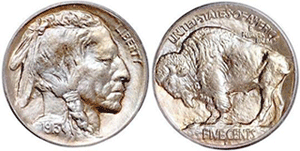
|
1913 Indian Head nickel
|
The talent of the person who altered the design ranged from master engravers (who created artistic masterpieces on these small, round pieces of metal) down to untalented individuals who at best did little more than deface the coins with crude scratches, punches and graffiti. The appearance of the Buffalo nickel in 1913 generated the beginning of hobo nickels. Even the buffalo on the reverse lent itself to being altered into another animal or even a man with a backpack.
The name hobo nickel is thought to have arisen from one of two sources. During the Great Depression in particular, some of the wandering hobos carved designs on an Indian Head nickel and then trade them for a meal or a place to spend the night. These hobos used a simple pocket knife or nails, perhaps a few punches fashioned out of old files or other tools, and a hammer to create a design. The standard hobo nickel has the Indian’s head altered into a man wearing a rounded derby-style hat with a beard, ear, and collar(s). Nicer specimens may have the profile changed, and possibly a cigar, cigarette or wording added.
The term hobo nickel may have also come from Hoboken, N.J., during World War I. More than three million American soldiers passed through Hoboken, the prime port of embarkation for the American Expeditionary Forces. Oftentimes, to pass the down time in military camps, many soldiers picked up the popular hobby of carving designs into the new Indian Head nickels.
|

|
|
Hobo nickels by modern carvers (l-r): Amy Armstrong, Ron Landis,
Ron Landis and Andy Gonzales.
|
Although much appreciated today, the nickels at the time were considered debased and worthless as money. Many of these hobo nickels ultimately showed up in jars in the many bars around Hoboken after the soldiers pulled them out for a few laughs from the bartender. Many of these nickels featured a rendition of the Kaiser. Whether the term hobo nickel arose from Hoboken, N.J, or from the hobos during the Great Depression, it has become the commonly accepted term to describe these miniature works of art. They are also sometimes referred to as “reworked,” “transformed,” “bum nickels,” “trench art,” or “prisoner nickels.”
Nearly all the “old” or classic hobo nickels (before 1980) were made in obscurity by many hundreds of different people, not all of whom were hobos. No records were kept, and nothing contemporary appears to have been chronicled or published by the early hobo nickel makers, reporters or authors on this little-known practice of carving coins.
In the 1980s, a whole new generation of hobo nickel carvers arose, giving new life to this earlier art. Some of their works copied earlier designs while others created new designs not previously seen. Carvers like John Dorusha, Frank Brazzell and Wabon Eddings were some of the most prolific.
Since the late 1990s, yet an even newer generation of hobo nickel carvers has emerged. Some of these carvers are true artisans and have created remarkable pieces of miniature art work. The quality of workmanship is oftentimes superior, and these artists are creating new and different designs never imagined in years past. The vast majority of the contemporary hobo nickel artists sign their work. Most of the early hobo nickels were unsigned.
Certain unknown carvers created a body of work that is identifiable as being by a particular unknown artist. Over time, the Original Hobo Nickel Society (founded in 1992) has provided nicknames for some of these artists. One of the better known of these is “Peanut Ear.”
The value of hobo nickels to collectors is primarily based on the quality of the carving or engraving on the nickel. The better the carving, the higher price the nickel will yield. High-quality, older carvings generally are more desirable than contemporary carvings of similar quality. Old or classic carvings on high-mint state nickels are highly desirable. Old or classic carvings can sell from as low as $5-$10 for a crude example up to as much as $10,000 for a sought-after example. Nicely done classic carvings usually sell in the range of $125-$500. Contemporary carvings can also sell for as low $5-$10 for a poorly executed piece to up to $7,000 or more for some finely crafted nickels. A nice contemporary carving usually sells in the $100-$500 range.
-------------------------
For more information, go to the Original Hobo Nickel Society website at www.hobonickels.org
or contact the author at hobobazoo@gmail.com.
|
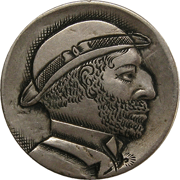
A classic hobo nickel by an
unknown artist.
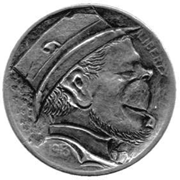
A classic nickel of an Irishman,
unknown artist.
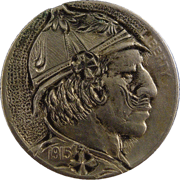
A classic of Kaiser Wilhelm.
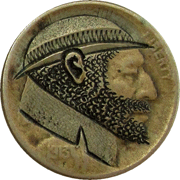
A classic no-neck style nickel.
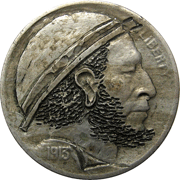
Unknown carver nicknamed “Peanut Ear” for an obvious reason.
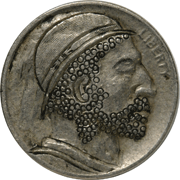
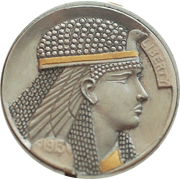
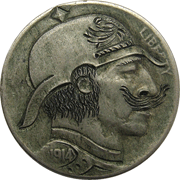
|